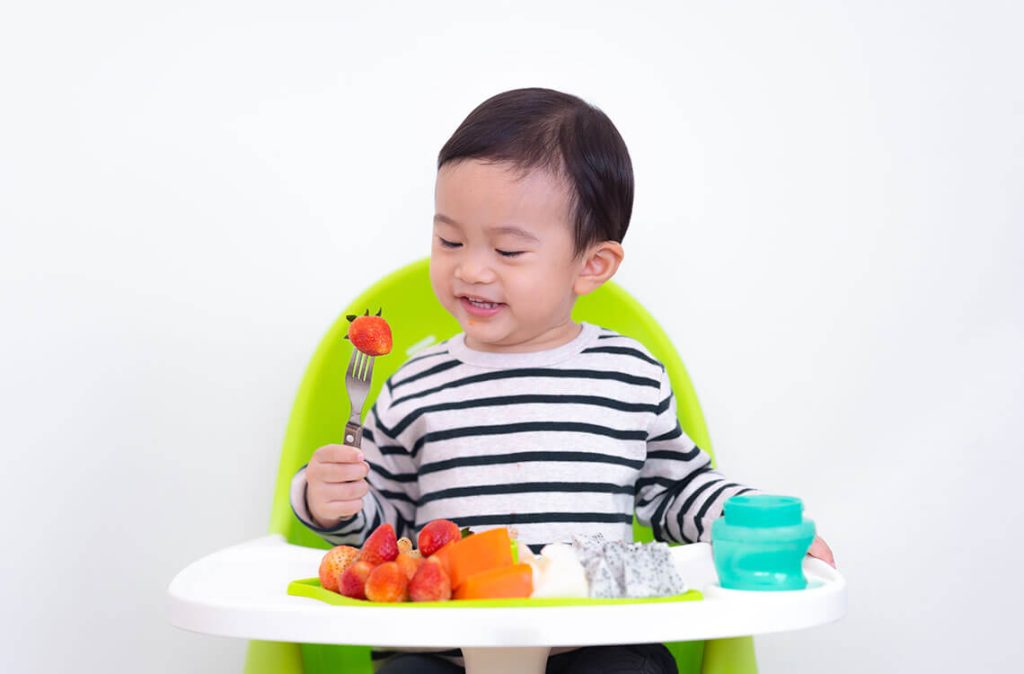At three years old your toddler should up their caloric intake by a fraction.
But the general rule of thumb still falls somewhere between 1000 to 1400 calories a day, depending on their energy expenditure and BMI.
If your child hasn’t already shown picky eater tendencies at 2 years old, they may now that they’re a year older.
In this case it’s important to make food a little bit more flavourful.
Your child’s taste buds will have fully developed at this age, resulting in the desire for more decadent meals.
Three years old is also alright for mild, spicy foods.
Here’s a short list of what and what not to feed your children at three years old.
What to Feed
Carbohydrates
Incorporate lots of healthy carbs in your child’s diet.
Admittedly, whole grains are the gold standard.
But normal white bread or white rice is still acceptable. Especially if the whole-wheat option is not readily available or too expensive.
Cereals and oatmeal are also good carb options.
Other carb-rich foods that you may want to start introducing to your child can include pasta dishes, mashed potatoes, chapatti, noodles, tacos, and pizza.
Fruits and Vegetables
Encourage your three-year-old to consume a variety of fruits and vegetables to provide essential vitamins, minerals, and dietary fibre.
Include options such as strawberries, bananas, oranges, grapes, cucumbers, carrots, peas, and sweet potatoes.
Offer them as snacks, in salads, side dishes or stir-fries with meals.
If your child is a bit of a picky eater, consider incorporating vegetable purees into soups and other cooking.
Lean Proteins
Ensure your three-year-old receives adequate protein for growth and development.
Lean sources such as chicken, turkey, fish, and legumes like lentils and beans.
Diversify their meals by introducing more appetising foods like fish and chips, chicken curry, meatballs, and beef stew.
Your child will have developed a stronger sense of flavour at three-years-old.
Dairy and Calcium-Rich Foods
Include dairy products in your child’s diet to support their bone health. Offer milk, cheese, and yogurt as part of their daily intake.
If your child has lactose intolerance or follows a vegan diet, consider alternatives like fortified plant-based milk and calcium-rich foods like tofu, almond milk, and leafy greens.
At three years old they are able to drink whole milk on its own.
Healthy Fats
Healthy fats are essential for brain development and overall health.
Incorporate sources like avocados, nut butters (if there are no allergies), and olive oil into your child’s meals.
Fatty fish, while expensive is a good source of omega-3 fatty acids.
Other sources of cheap, healthy fats include whole eggs, peanut butter (if they are not allergic) and tofu.
What Not to Feed
Added Sugars
Minimise the consumption of foods and beverages high in added sugars.
Avoid sodas, fruit juices with added sugar, candies, and sugary snacks.
Instead, opt for fresh fruits as a natural and healthier alternative for sweet cravings.
Remember to read the ingredients and look at the nutrition label.
Added sugar is in everything these days. Even things that you would least suspect.
Processed Foods
Many parents are tempted to buy loads of processed foods for their kids because they’re easy to prepare.
Things like processed cheese, sausages, soft drinks and biscuits are some popular ones.
Limit the intake of processed and packaged foods as they often contain unhealthy levels of sodium, unhealthy fats, sugars and additives.
Choose whole and minimally processed foods whenever possible.
Unhealthy Fats
Avoid foods high in unhealthy fats, such as deep-fried and greasy items.
This includes things like doughnuts and fried chicken. These can contribute to weight gain and other health issues.
Opt for healthier cooking methods like baking, grilling, or steaming.
When using oil, try to opt for good oils like sunflower oil instead of palm oil.
Choking Hazards
Be cautious of foods that can pose a choking hazard, as three-year-olds are still developing their chewing and swallowing skills.
Avoid offering whole grapes, popcorn, nuts, hard candies, and large chunks of meat or vegetables.
Cut food into small, bite-sized pieces and supervise mealtime closely.
At three years old, your toddler can still have trouble with large pieces of food.
Tantalise Your Toddler’s Tastebuds
At three years old your toddler is slowly graduating from bland, boring foods to more adventurous menu items.
They may even start craving adult foods that you yourself normally eat.
As long as it’s healthy and full of nutrients then there’s no harm in letting your little one join in at the dinner table as one of the grown-ups.
Just remember to take it easy and give them small portions.
They will slowly discover the joys of eating in no time.
For more insightful stories and fun recipes, stay tuned to Motherhood Story!
